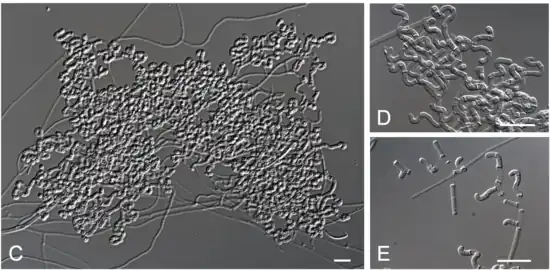Arachnomyces bostrychodes
Arachnomyces bostrychodes is a species of infectious ascomycete fungus discovered in 2021 from clinical specimens of fungal strains in Texas, United States.[1][2]
| Arachnomyces bostrychodes | |
|---|---|
 | |
| A. bostrychodes colony | |
| Scientific classification | |
| Domain: | Eukaryota |
| Kingdom: | Fungi |
| Division: | Ascomycota |
| Class: | Eurotiomycetes |
| Order: | Arachnomycetales |
| Family: | Arachnomycetaceae |
| Genus: | Arachnomyces |
| Species: | A. bostrychodes |
| Binomial name | |
| Arachnomyces bostrychodes Rodr.-Andr., Cano & Stchigel 2021[1] | |
Etymology
The specific epithet comes from the Greek βοστρυχος-, meaning curl, referencing the curly appearance of the reproductive hyphae.[1]
Morphology and asexual reproduction
A. bostrychodes grows septate, hyaline, branched, vegetative hyphae with smooth and thin walls, between 1 and 2 μm wide. The fertile hyphae are well-differentiated, arising as lateral branches from the vegetative hyphae, successively branching to form dense, tightly curled, sinuous clusters that are also between 1 and 2 μm wide, forming random arthroconidia both intercalary and terminally.[1]
The conidia measure 4–8 x 1–2 μm, are mostly curved and truncated at one or more commonly both ends; they are enteroarthric, hyaline, one-celled, smooth-walled, cylindrical, barrel-shaped; they are finger-shaped when terminal. The conidia are separated from the fertile hyphae by rhexolysis. There have been no observations of chlamydospores, racquet-shaped hyphae, setae, or sexual reproduction.[1]

References
- Rodríguez-Andrade E, Cano-Lira JF, Wiederhold N, et al. (7 September 2021). "A revision of malbranchea-like fungi from clinical specimens in the United States of America reveals unexpected novelty". IMA Fungus. 12 (1): 25. doi:10.1186/s43008-021-00075-x. ISSN 2210-6359. PMC 8422767. PMID 34493345.
- "Arachnomyces bostrychodes". National Center for Biotechnology Information (NCBI). Retrieved 6 September 2022.